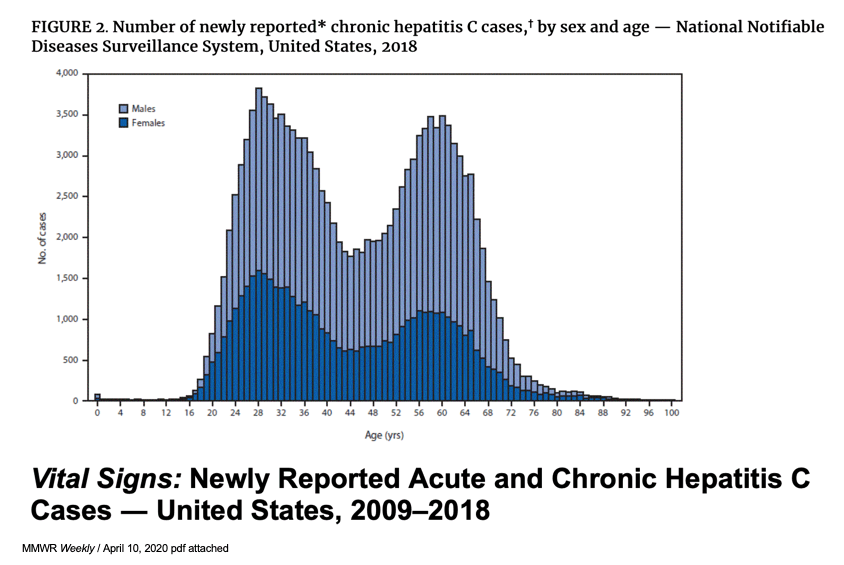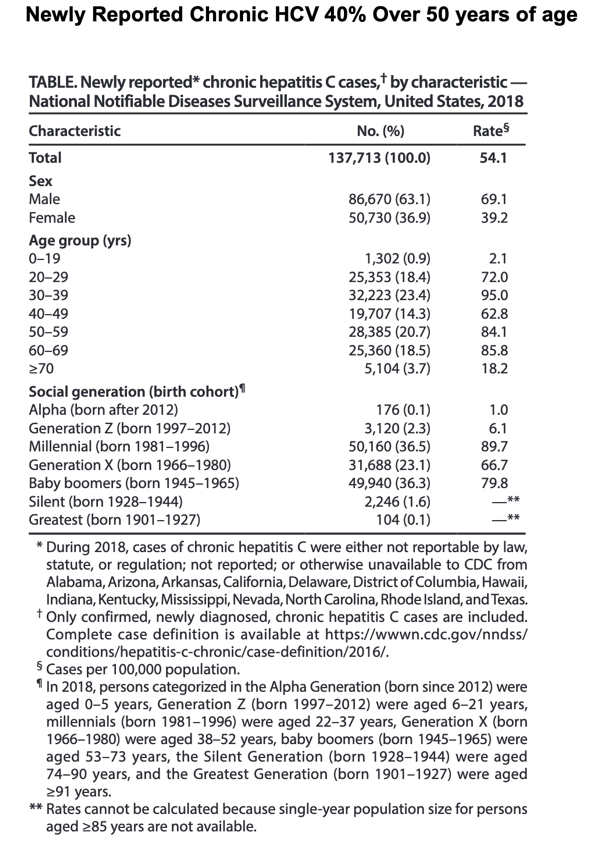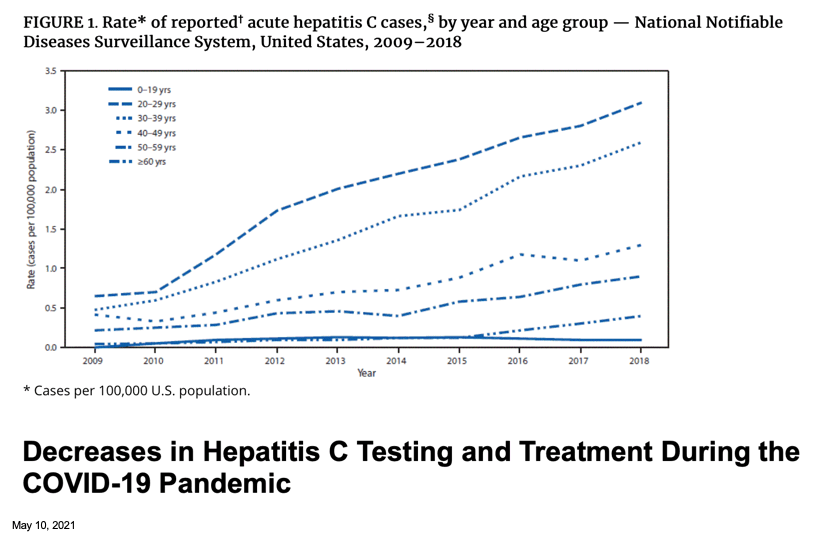| |
CDC: Older Adults Overlooked - Age 50-69 Highest Chronic HCV Rates along with Young
|
| |
| |
Among both males and females, a bimodal age distribution was observed, with the largest proportion of all newly reported chronic cases among persons aged 20-39 and 50-69 years (Figure 2).
These findings highlight the need for immediate implementation of the new CDC universal hepatitis C screening recommendations for all adults and pregnant women (11). Following a decade of sharp increases in acute hepatitis C infections, particularly among young adults, the rates of newly reported chronic infections among baby boomers and millennials are now equal
Older adult opioid overdose death rates on the rise - 4 times higher for African-American Men - (01/16/22)
Baby boomers accounted for 36.3% of newly reported chronic hepatitis C cases in 2018, persons born during 1966-1980 (Generation X) accounted for 23.1%, and those born during 1981-1996 (millennials) accounted for 36.5%. (Table). Among 2015-2018 NHANES participants aged ≥20 years who were HCV RNA-positive, 60.6% (95% CI = 46.1%-73.9%) reported having been told that they had hepatitis C.
These findings highlight the need for immediate implementation of the new CDC universal hepatitis C screening recommendations for all adults and pregnant women (11). Following a decade of sharp increases in acute hepatitis C infections, particularly among young adults, the rates of newly reported chronic infections among baby boomers and millennials are now equal, demonstrating that even younger generations are at risk. Diagnosing HCV infection is a necessary first step to linking persons to cure to prevent life-threatening consequences of long-term chronic infections and transmission to others.
Ecologic evidence reveals that CDC's 2012 recommendation to screen all baby boomers for HCV infection resulted in increased testing among that birth cohort (17). However, existing testing strategies have had limited success because >39% of all adults with HCV infection still report being unaware that they are infected. Further, the increase in new acute and newly reported chronic infections among young adults further supports the need for expanded and easier-to-implement hepatitis C testing recommendations. The new CDC recommendations released today include screening of all adults aged ≥18 years once in their lifetime and screening of all pregnant women during each pregnancy (11). They also include an exception for settings where the prevalence of HCV infection is <0.1%; however, there are few known settings with a hepatitis C prevalence below that threshold (18,19). The recommendation for testing of persons with risk factors remains in effect, regardless of age or setting prevalence, including continued periodic testing of persons with ongoing risk. The U.S. Preventive Services Task Force (USPSTF) recently published a recommendation statement on screening for hepatitis C virus infection in all adults aged 18-79 years (B recommendation) (20). The USPSTF recommendation differs from CDC's recommendation in that 1) an upper age limit is defined, 2) there is no recommendation for screening during every pregnancy, 3) and a prevalence threshold at which universal screening would remain cost-effective is not identified.

Summary
What is already known about this topic?
Acute hepatitis C infection is often asymptomatic, but >50% of cases will progress to chronic infection, which can be life-threatening. Hepatitis C can be diagnosed with a blood test and is curable.
What is added by this report?
The annual rate of reported acute hepatitis C tripled from 2009 to 2018 and was highest among persons aged 20-39 years. In 2018, the largest proportion of chronic hepatitis C cases occurred among persons aged 20-39 years and 50-69 years. Only 61% of adults with hepatitis C knew that they were infected.
What are the implications for public health practice?
All adults and pregnant women should be screened for hepatitis C according to CDC's new screening recommendations.


Introduction
The COVID-19 pandemic has disrupted healthcare services, reducing opportunities to conduct routine hepatitis C virus antibody screening, clinical care, and treatment. Therefore, people living with undiagnosed hepatitis C virus during the pandemic may later become identified at more advanced stages of the disease, leading to higher morbidity and mortality rates. Further, unidentified hepatitis C virus-infected individuals may continue to unknowingly transmit the virus to others.
Methods
To assess the impact of the COVID-19 pandemic, data were evaluated from a large national reference clinical laboratory and from national estimates of dispensed prescriptions for hepatitis C virus treatment. Investigators estimated the average number of hepatitis C virus antibody tests, hepatitis C virus antibody-positive test results, and hepatitis C virus RNA-positive test results by month in January-July for 2018 and 2019, compared with the same months in 2020. To assess the impact of hepatitis C virus treatment, dispensed hepatitis C virus direct-acting antiretroviral medications were examined for the same time periods. Statistical analyses of trends were performed using negative binomial models.
Results
Compared with the 2018 and 2019 months, hepatitis C virus antibody testing volume decreased 59% during April 2020 and rebounded to a 6% reduction in July 2020. The number of hepatitis C virus RNA-positive results fell by 62% in March 2020 and remained 39% below the baseline by July 2020. For hepatitis C virus treatment, prescriptions decreased 43% in May, 37% in June, and 38% in July relative to the corresponding months in 2018 and 2019.
Conclusions
During the COVID-19 pandemic, continued public health messaging, interventions and outreach programs to restore hepatitis C virus testing and treatment to prepandemic levels, and maintenance of public health efforts to eliminate hepatitis C infections remain important.
| |
| |
| |
|
|
|